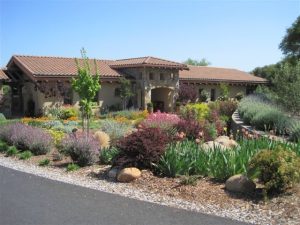The area where homes and landscapes meet wildland vegetation can be a beautiful and quiet place to live. However, the Rim Fire is a reminder that this area, commonly called the wildland-urban interface (WUI), is also where wildfires pose the biggest risk to people and structures.
Wildfires in the wildland-urban interface can spread to landscaping around the home, then to the house. Ultimately, protecting homes from wildfire requires that materials and design features of both the home and near-home vegetation be addressed-you can’t ignore either one.
Many homes ignite and are lost because wildfire-generated, wind-driven embers ignite dry vegetation that has accumulated either adjacent to homes or in gutters or on roofs. Make sure you remove these and other wind-blown vegetation debris on a regular basis.
In times of drought, water conservation requirements may lead to landscape vegetation being even more deprived of water, and as a result can make the fire risk higher. Creating a landscape that results in both fire safety and water conservation can rely on several techniques.
Plant placement is a very important factor in creating a fire-safe landscape. Avoid planting vegetation right next to the home. Pay special attention to your landscaping design so that your house is not surrounded by a sea of vegetation. Separate individual plants or small groupings, both horizontally and vertically. Then, if one plant ignites, the fire isn’t carried to the next plant.
Consider designing your landscaping as a series of ‘islands’ to break up the connectivity between your landscaping and your home. These islands should be separated with hardscape elements such as patios, walkways, dry-stacked walls or other non-planted areas. These areas can act as fuel breaks.
When inspecting the vegetation around your home, it is helpful to divide the space into three zones-one near the home (within 30-feet or so), one that extends outward from 30 to about 100 feet, and one that extends from 100 to 300 feet. Be more careful about the condition of the vegetation in the zone closest to your home. Is the vegetation green and lush or old and full of dead material? Do you have tree branches near to or over your house? Overhanging vegetation and dead material within a plant require immediate attention.
Tips for water-thrifty landscapes that protect property from wildfire
- Choose individual plants that are both fire-resistant and drought-tolerant, with the following characteristics:
- Produce limited dead and fine material
- Retain high moisture content with limited watering
- Have a low and open growth form
- Have low levels of volatile oils and resins
- Reduce the area of your landscape to fewer plants that are well maintained and healthy.
- Maintain irrigation systems properly-check them frequently for leaks, and adjust both manual and automatic watering schedules based on the weather and soil moisture.
- Water only as needed to keep plants healthy. For many woody plants (trees and shrubs), deep and infrequent watering will promote deeper root growth.
- Keep trees and shrubs healthy by pruning and removing dead growth. The goal is to maintain an open growth form.
- Use mulch as needed to perform one of their beneficial landscaping functions (i.e., retain soil moisture and limit erosion). Many organic types of mulch are fine from a fire safety perspective if they are kept more than 5 to 10 feet from the home; gravel (inorganic) mulches can be used in these locations. Generally mulch should be 2 to 4 inches deep. Needle mulches or mulch having fine hairy components should be avoided as they readily ignite. Rubber mulches should be avoided in wildfire prone areas.
- Remove weeds to reduce competition with plants for limited water. Mulches can be used to inhibit weeds. Group plants together that have similar water requirements.
This article adapted from Cooperative State Research, Education and Extension Service, USDA. The University of California has a number of fire-safe resources available at http://cecentralsierra.ucanr.edu, http://firecenter.berkeley.edu/homeassessment/ and http://www.extension.org/surviving_wildfire
Scott Oneto is the UCCE Central Sierra County Director, serving Amador, Calaveras, El Dorado and Tuolumne Counties.


